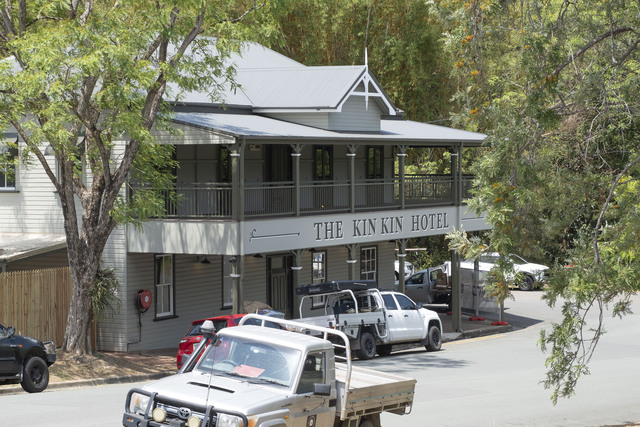Allan and Jann Bonsall have lived in Kin Kin for 15 years, are members of the Kin Kin Community Group and have served on its executive.
This week a cafe van opened on Butter Factory Park to provide locals with a cafe, food outlet and meeting place that have been absent in the small town for the past two months since its only cafe, the Blackant, closed for renovations. The recent loss of services is one of several issues impacting the amenity of Kin Kin residents, which Allan Bonsall discusses here.
In past months articles in the media have extolled the vision of the new owner of the Kin Kin Hotel – a vision that supports local growers and farmers through a bespoke culinary experience, coupled with an exclusive refurbishment of the hotel.
It all sounds very exciting, and an economic boon for the village.
What the stories don’t reveal is the pain being suffered by the Kin Kin community due to the divisiveness of the plan.
Kin Kin is a beautiful place, home to 800 people secluded from the pressures of suburban Australia. Farmers rub shoulders with tradies and professionals, all with a strong sense of community, passionately protecting the shared values living in such a place brings.
Pre-Covid the town was a quiet but happy village. The social buzz centred on the iconic Queensland pub, and the highly regarded Blackant café. Both enjoyed strong trade.
Post-Covid the centre of the village is deserted except for locals picking up parcels from the post office, and the odd dog walker. The café is closed for renovations, with no indication when it will reopen. The pub is open four days a week with restricted hours.
Between those two date claimers the pub and the café changed hands. First to go was the hotel, which went into hibernation for two years while the renovations began.
The developer then bought the Blackant café business. What had been an essential hub for the locals soon became anything but. Opening hours chopped and changed, lunch menus began to disappear, and newspapers and grocery essentials did likewise. Disgruntled villagers accused the owner of forsaking the local community in favour of a tourist driven, up market clientele.
If the new owners were happy, they didn’t share that emotion, leaving in their wake an unhappy and divided community.
Kin Kin is no stranger to money and politics playing havoc with the wellbeing of the community.
In 1987 a Kin Kin landholder was granted approval by council to open a small, local quarry to service the needs of the shire. Three different operators struggled to make it viable. In 2020 Cordwells Resources acquired the operator’s licence, significantly increasing output.
For the residents who live with the quarry, its operation is a nightmare. Dust and noise are unavoidable sideshows, while the circus of finger pointing and ducking for cover between the state government and the council looms large in every aspect. The residents don’t care who is responsible, they simply want the noise and dust to stop disrupting their lives.
Equally frustrating is the role of the judiciary. In mid-2022 the council took the operators to the Environment Court. Two years on and we are still waiting for a judgement.
The primary haulage route from Shepperson’s Lane to the Bruce Highway is Kin Kin Rd, a distance of 27 kilometres, and adjudged by experts as unfit for use by truck and dog combinations. Several hundred residents live along the road, many operate businesses from their homes. Massive trucks thunder past every few minutes. It’s a typical country road, in many places so narrow trucks struggle to stay inside the white lines. The litany of near misses is scary.
The state government has conceded the problem by authorising extensive upgrades, including Six Mile bridge and recent work on the range. Now the state has authorised a further $36.5 million to complete the upgrade to the range, and between the range and the one-way bridge at Eastern Branch Road. Estimates of the total spend are between $72 million to over $100 million. The one way bridge will not be touched.
Residents question why this is being done? Why would government spend over $100 million on a small country road that appears adequate for local traffic?
The logic doesn’t stack up. A previous mayor of Gympie was bemused by the state government’s obsession with Kin Kin quarry, arguing that there was more than enough supply from existing quarries with far more cost-effective haulage routes to service north and south upgrades to the Bruce.
Compounding the problem is the time frame. The recent upgrade at Six Mile Creek imposed an 18 month disruption on the daily lives of hundreds of people. The work on the range added another 9 months. The next stages are due to start in 2025 for completion in 2028. Coupled with the work just completed, residents will face over five and a half years of road works.
Nor can the irony of establishing an upmarket tourist facility in Kin Kin be ignored. There have been countless examples of people driving across the range from Pomona, vowing they will never do it again. An unexpected encounter with a fully laden quarry truck on a narrow road is enough to put anyone off their lunch. The odds are stacked against the visitor. Under the terms of the quarry management plan the operator is able to run at least 24 truck movements every hour.
And, by extolling the wonders of the Noosa Country Drive does Tourism Noosa give any thought to the safety of the tourists doing so.
The town is divided about the quarry. Some fervently want it gone. Others who live away from the main haulage route, are more ambivalent, until you talk safety.
Now the town is facing a new dilemma. With the café closed there is nowhere to buy essentials such as bread or milk. Pomona is 14 km away.
Consideration has been given to opening the community house canteen with a volunteer roster to ensure staples are available. The Facebook post suggesting the idea was crammed with positive responses, many decrying the division that has been created since the hotel was sold.
The finger is pointed squarely at the people who appear to have ignored the needs of the community, and in the process created a great deal of anger. But no-one in the community, or it appears within council, has the capacity to resolve the anger. We are exposed to the inevitability of money being used to create more money, of greed dictating how we should live as a community.
There is a solution, but very rarely can the solution meet the demands of every vested interest. What the developer wants is different to what residents want. What Main Road’s engineers want is potentially contrary to the lifestyle you currently enjoy. Finding the balance is the bane of politician’s lives.
I believe that balance is called “amenity”.
In land use planning, amenity is something that is considered to benefit a location, contribute to its enjoyment, and thereby increase its value.
Tangible amenities can be on your property, such as a swimming pool, or from surrounding infrastructure, such as footpaths.
Intangible amenities include well-integrated transport solutions, pleasant views, as well as environmental amenities such as trees, clean air and clean water.
In essence “amenity” is about the pleasantness and good functioning of an area.
Some jurisdictions have planning guidelines to minimise the impact on amenity. NSW guidelines seek to minimise amenity impacts from development or change. The South Gloucestershire Council in the UK has specific guidelines which acknowledge that the health and well-being of residents is often directly related to the level of residential amenity.
There are no apparent “amenity” guidelines issued by the Queensland Government to protect the healthy lifestyle rights of property owners.
If the correct amenity guidelines were applied to Kin Kin and the hinterland, we might expect a completely different outcome than that imposed by the current pursuit of profit.
The starting point would be the road. For any quarry to be considered for approval there would be appropriate infrastructure to support the operation without impacting on the “amenity” of the residents. If approval required significant upgrades to the roads, it could only be given if any loss of amenity was considered acceptable.
If a developer was looking to create a vision that would significantly alter residential “amenity”, there would have to be consideration of all the impacts those changes would have, including supply of basic services.
The solution is not simple. If such amenity guidelines were introduced, how would they apply to existing permits? How would the guidelines be determined? How would they be controlled? At what level of government?
I wonder if there is a party contesting the next election that’s even prepared to countenance this type of “amenity” revolution – never mind implement it.
Allan Bonsall, Kin Kin resident for 15 years.








